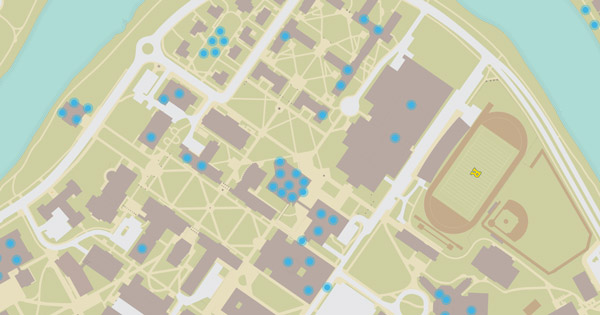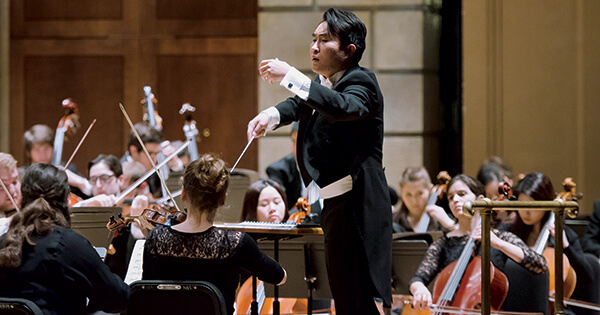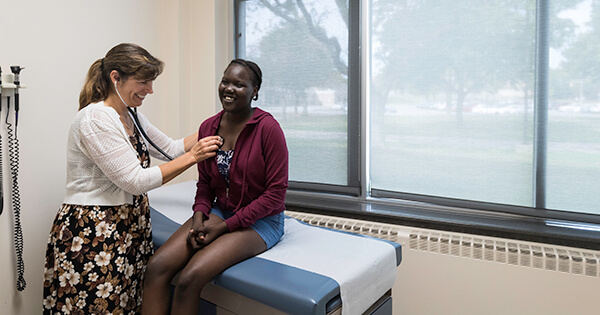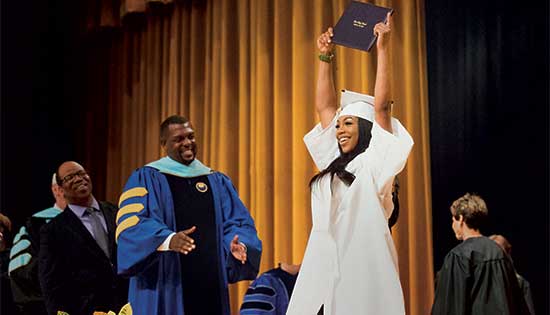Joel Seligman’s farewell address
Joel Seligman’s farewell address
Joel Seligman, who is stepping down as University president and CEO at the end of the month, presents his farewell address at the Memorial Art Gallery. “More than anything else in my time here, I wanted to help lead the University’s efforts to become an ever stronger research University,” he said. (University of Rochester photo / J. Adam Fenster)
Joel Seligman
Farewell Address
February 13, 2018
You do not fully become a University president the day you are appointed or your first day on the job. You grow into the job. Over time you develop a sense of the needs and preferences of those with whom you work and the extraordinary complexity of helping lead an institution with 2,780 faculty, more than 11,000 students, more than 100,000 alumni, seven schools, a Laboratory for Laser Energetics, a Memorial Art Gallery, a burgeoning health care system with six hospitals, three ambulatory surgical centers, six urgent care centers, an accountable care system with more than 2,000 doctors. You help lead an institution with great science and engineering programs such as our Institute for Optics, the nation’s leading School of Music and outstanding graduate schools in fields as disparate as education, business, nursing, the life and social sciences as well as the humanities. Your job as a University president is nonstop – you are responsible for managing and inspiring this complex of ambitions, people, schools, hospitals, clinical care, cutting-edge research, education and community involvement with an overall budget of $4 billion. You are expected to help raise new resources whether from fundraising and capital campaigns, governments, foundations or corporations to help the University grow. You play a personal role in hiring and retaining some of the finest administrators, faculty and staff you can help attract to the University. You are the University’s chief strategist, the cheerleader-in-chief, the ultimate supervisor, the primary face of the University to government, our communities, national and international academic leadership. The job is 24/7. Crises happen when they happen, sometimes at three in the morning. Many weeks there are a succession of 14, 15 and 16 hour days. You are frequently traveling, often flying on regional jets, slowed by long delays in airports or on runways, arriving at hotels at 10, 11, 12 at night before 7 am meetings. You must be patient, you must be a good listener. When things go well, you often get credit you do not deserve. When things go badly, you are frequently blamed.
Above all else, you are charged with having the judgment to balance a never-ending series of conflicting requests for resources with the knowledge that you will never have enough to satisfy everyone. It is this sense of balance, the quality of your judgment that separates successful from unsuccessful university presidents.
A Board member I particularly respect recently asserted to me: “This must be the worst friggin’ job in the Universe.”
I disagreed. This is the best job in the Universe. If you are fortunate, as I have been for 12 wonderful years, you have a chance to work with amazing faculty, students, staff, Board members, alumni and friends in the community. Together we have helped strengthen one of the most important social institutions that the world has ever known – a modern research University. Together we have helped educate the most inspiring students, support extraordinary faculty, collaborate with indefatigable administrators and staff – all devoted to making the world ever better.
And we were values driven, committed to academic excellence, academic freedom, diversity and our community.
My first public words when I officially accepted this position on December 1, 2004 were: “I am a builder, not a cutter.” You gave me the opportunity to work with you to help strengthen a University with more great students, more outstanding faculty, many new facilities and an increased number of consequential programs. I had the chance to meet and in some instances to become friends with fascinating, idealistic, hard-working scientists, performers, researchers and scholars. I will forever cherish my friendship with the late Eastman School of Music Dean Doug Lowry. I also had the chance to work with so many members of our staff – janitors, often my special friends at 6 or 7 am; so many individuals in the Department of Public Safety and parking; the IT staff who put up with my congenital inability to master the simplest technology; administrative assistants who often worked late into the night to help meet my impossible deadlines; road warriors in Advancement who each year attended dozens of events with me, often away from their spouses and children; nurses and technicians in our hospitals, the people who along with doctors are dedicated to saving lives and improving the quality of life.
I threw myself body and soul into this job because I loved the opportunity to serve and the people with whom I worked. I have no regrets. I feel no bitterness. Being President of the University of Rochester involved far more joy than pain. As a colleague in academic administration once told me: “If 80 percent of your days are good days, you are doing fabulously.” I did fabulously.
More than anything else in my time here, I wanted to help lead the University’s efforts to become an ever stronger research University. Let me in my final public address as University president offer a few reflections on the University’s future.
I was animated by a vision. By 2025, I envisioned the University of Rochester achieving a more prominent place among the nation’s leading research universities with path-breaking initiatives that lead through research, innovate in education, build and embrace our community and transform health care. During these years, the University can fortify its role in pivotal domains in data science and neuroscience and further develop cutting-edge programs such as Augmented and Virtual Reality, High Energy Density Physics, Cancer or RNA Biology. The University can innovate in education through critical investments in digital learning, diversity, career development, the humanities and the performing arts. The University can strengthen its leadership in the Rochester community through projects such as the East High School initiative and commitments to economic development, poverty reduction and environmental sustainability. The University can expand its already preeminent role in regional health care by growing the scale of its patient network, ensuring that its inpatient and outpatient facilities equal the caliber of our outstanding faculty. The University of Rochester can do all of this while achieving financial sustainability for the University and each of its schools and creating an ever more inclusive and supportive environment for all faculty, students, staff, trustees and alumni.
This is not my vision alone. This was the emerging vision of the 2018–2025 Strategic Plan which I and so many others worked on until very recently.
After an interval in which the University’s focus necessarily will be on healing, a vision such as this may again be embraced by the University in its next strategic plan.
Under any circumstance, I urge the University to continue with full vigor several important projects begun in 2015 as part of the Next Level strategic initiative. These include:
Data Science: Data science is one of the defining fields of the 21st century for the University and indeed the country. The University four years ago made a commitment to be in the vanguard of the digital revolution. We are delivering on that commitment. Since 2015 when the University articulated a $100 million objective to develop best-in-class or near-best-in-class programs in specified domains of Data Science, we have made substantial progress. To date, we have secured this initial $100 million commitment led by more than $40 million in philanthropy and $22.5 million from the State of New York on top of an earlier $10.5 million. The University has dedicated Wegmans Hall, home of our Goergen Institute for Data Science, been named a Center of Excellence by New York State, hired 23 new faculty in computer science and data science applications throughout the University, and developed a new Data Science bachelor’s program and a new Data Science master’s program. We have received National Science Foundation support for PhD research training and research experience for undergraduates. The University also has organized the Rochester Data Science Consortium to foster partnerships with government and industry, including a recent arrangement with Harris Corporation. Between 2009 and 2017, federal and state awards for data science at the University totaled $819 million with notable NIH-funded projects in Respiratory Pathogens, the New York Influenza Center of Excellence and the Center for Immune Bioengineering.
Neuroscience: The 21st century will be the century of the brain as health care and the life sciences seek to conquer some of the most intractable challenges of the human condition from Alzheimer’s to stroke to aging. The University is already among the top 50 Best Global Universities for Neuroscience and Behavior in U.S. News & World Report and in 2016 and 2017 added ten new faculty in Neuroscience. The University has taken several initial steps in Neuroscience, including hiring John Foxe, the Kilian J. and Caroline F. Schmitt Chair in Neuroscience and Director of the Del Monte Institute. Neuroscience is the Medical Center’s largest research program in terms of funding and numbers of researchers and departments, coordinating neurological research through 17 centers for excellence with a total of 86 faculty who received $52 million of sponsored research support between 2012 and 2016. The Neuroscience strategic plan provides a blueprint for accelerated progress in such areas as The Rochester Center for Alzheimer’s Disease, the Rochester Intellectual and Development Disabilities Center, the Rochester Center for Health and Technology and in tandem with Data Science, Augmented and Virtual Reality.
Humanities and the Performing Arts: We believe that the finest students are more likely to attend our University with aspirations for careers in health, law, business, engineering or fields which require a graduate degree if we provide a broad liberal arts education that introduces students to the breadth of human experience. We anticipate celebrating the Eastman School’s 100th anniversary in 2021-2022 to prepare the School for its next generation of leadership in musicianship. Within the past few years we have established a Humanities Center for which we have created a physical space in the Rush Rhees Library and established an Institute for the Performing Arts. We are proud of our International Theatre program, our outstanding Memorial Art Gallery, our program in Dance and Movement, our special collections holdings in our libraries, and collaborative programs such as those in the Medical Humanities and Audio and Music Engineering. We are well along with the funding for the new Sloan Theatre on the River Campus. We believe that the ability to provide a liberal arts education will be one of the decisive ways that we can fortify our position as one of the nation’s leading research universities. According to a 2017 World University ranking, the University of Rochester is among the top ten universities in the United States in the performing arts.
The Community: We today exist in the Rochester, national and international communities. All matter. We are One University, committed to being welcoming and respectful of all of our students, faculty and staff. Accelerated progress is now being achieved, building on the 2016 Report of the Commission on Race and Diversity and the recently created Commission on Women and Gender Equity in Academia. We are building stronger links to the Rochester community through our path-breaking initiative at East High School and the new Center for Urban Education Success, the Rochester-Monroe Anti-Poverty Initiative and several key economic development programs, including the Ain Center for Entrepreneurship, High Tech Rochester, the Center for Emerging and Innovative Sciences, Brooks Crossing, College Town and AIM Photonics. We are deeply involved in the cultural life of Rochester through our remarkable Eastman School of Music and Memorial Art Gallery. The University has played a critical role in community planning through the Regional Economic Development Council with projects such as the Eastman Business Park and the downtown Innovation Zone.
We are the largest employer in the region with more than 30,000 employees in the University and our affiliates. Unlike the more affluent communities that surround it, the City of Rochester today is challenged with a declining population, high rates of poverty and K-12 graduation rates perennially below 50 percent. These realities have heightened our sense of moral responsibility to our friends and neighbors. We cannot alone be the saviors of Rochester, but, consistent with our academic mission, we have participated in meaningful steps to strengthen our City and our region.
Health Care: The strategic planning efforts now furthest along are those in the Medical Center, some of which date back to 2013. Medical Center CEO and Dean of the School of Medicine and Dentistry Mark Taubman and his extraordinary senior leadership team have developed five goals for the Medical Center strategic plan. First, to be upstate New York’s premier health care system by increasing upstate patient care through a growing primary care network and burgeoning regional care network that deserves special plaudits for leadership in addressing the health care challenges of several adjacent rural counties. Strong Memorial Hospital is the region’s leading safety net, today providing $115 million in uncompensated and not fully compensated care for our region. Second, the Medical Center is an international leader in critical areas of biomedical research, including clinical and translational research and biomedical informatics and key research domains in oral health. Third, the University of Rochester Medical Center long has been a curricular leader in health care education with programs such as the Double Helix Curriculum and our Biopsychosocial Model – leadership that today continues with our Institute for Innovative Education jointly led by the School of Medicine and Dentistry and the School of Nursing.
In the past few years the Medical Center has constructed several consequential new facilities, including the Saunders Research Building, the Wilmot Cancer Institute and the Golisano Children’s Hospital. The one consistency in every new strategic project that was launched at the Medical Center during the past 13 years is that they have been successful both in providing patient and family care and in terms of financial sustainability. The Medical Center today is far advanced toward the launch of two of the largest projects in its history – the long overdue expansion of the Emergency Department, which now treats roughly twice as many patients as it was built for, and the construction of a new Orthopaedics Campus, based on our national leadership in orthopaedics research and world-class musculoskeletal clinical care.
There are two fundamental challenges to continuing the University’s strong momentum forward.
To succeed, we must be One University. This does not mean that there should not be intellectual disagreements and fervent debate. It does mean that our discussions should be conducted with mutual trust and respect. Progress for any institution is based on a kind of magic when we unite behind common goals. For much of the past 12 years, we had this type of magic. We were never unanimous in our thought, but we were sufficiently aligned to progress in ways that very few universities did during that period. We now need a new period of mutual trust and mutual respect. I am hopeful by rallying around a new leader that this will occur.
We also must preserve a sense of perspective. The University is a complex institution with multiple needs. The next leader will need to address seven schools, the Medical Center, several affiliated institutions and be conversant in budgeting, facilities development, diversity and inclusiveness and strategic planning, among many other topics simultaneously. You cannot lead a University as complex as ours by playing favorites. You need always to bear in mind that each faculty member, each student, each senior leader and member of the staff matters, each alumnus or alumna matters, health care in our region matters, our efforts to be a national leader in research matter, our efforts to develop forms of education that best prepare our students to be leaders and rounded human beings matter, our commitment to our communities matters.
I am confident that our interim President Rich Feldman and our Board will provide a successful bridge to the choice of the next President. I also am confident that the new president will build on a strong platform and take the University far further in the years to come.
As for myself, for close to 23 years in two law schools and the University of Rochester, the goddess Fortuna smiled on me in my efforts to build stronger and wiser institutions. I never doubted that I was very fortunate. As Napoleon put it when asked what he looked for in his generals, “I like the lucky ones.” I was one of the lucky ones.
I look forward to returning to being a teacher and scholar. I loved teaching and writing and was proud of the life I led for the first 17 years of my academic career.
I will take a sabbatical elsewhere next year. I will return to Rochester the year after that.
Let me close with my two favorite words. Thank you. Thank you for the opportunity to have served. It has been the honor of a lifetime. I am grateful to each and every member of the University of Rochester family. Let me especially thank the three great chairs with whom I have worked: Bob Witmer, Ed Hajim and Danny Wegman. Each has provided yeoman service to advance our University.
I will always be a Yellowjacket. I will always love the University of Rochester. With all my heart I believe that the best days of the University of Rochester are yet to come.
As University of Rochester President, I now bid you a fond farewell.
—The above transcript was made available by the University of Rochester Office of the President.





